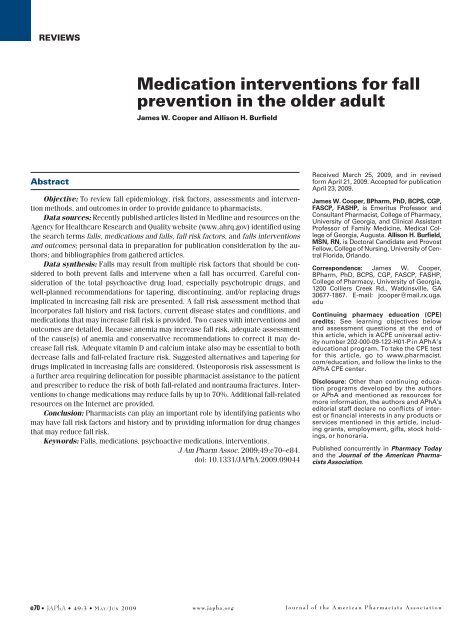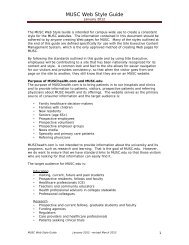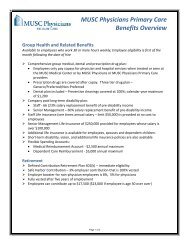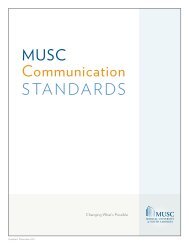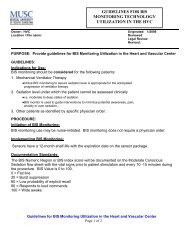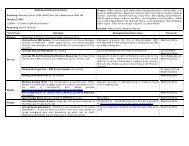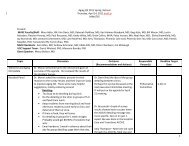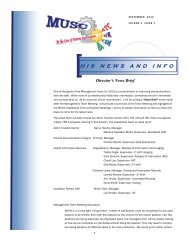"Medication Interventions for Fall Prevention in the Older Adult." J
"Medication Interventions for Fall Prevention in the Older Adult." J
"Medication Interventions for Fall Prevention in the Older Adult." J
Create successful ePaper yourself
Turn your PDF publications into a flip-book with our unique Google optimized e-Paper software.
Reviews<strong>Medication</strong> <strong>in</strong>terventions <strong>for</strong> fallprevention <strong>in</strong> <strong>the</strong> older adultJames W. Cooper and Allison H. BurfieldAbstractObjective: To review fall epidemiology, risk factors, assessments and <strong>in</strong>terventionmethods, and outcomes <strong>in</strong> order to provide guidance to pharmacists.Data sources: Recently published articles listed <strong>in</strong> Medl<strong>in</strong>e and resources on <strong>the</strong>Agency <strong>for</strong> Healthcare Research and Quality website (www.ahrq.gov) identified us<strong>in</strong>g<strong>the</strong> search terms falls, medications and falls, fall risk factors, and falls <strong>in</strong>terventionsand outcomes; personal data <strong>in</strong> preparation <strong>for</strong> publication consideration by <strong>the</strong> authors;and bibliographies from ga<strong>the</strong>red articles.Data syn<strong>the</strong>sis: <strong>Fall</strong>s may result from multiple risk factors that should be consideredto both prevent falls and <strong>in</strong>tervene when a fall has occurred. Careful considerationof <strong>the</strong> total psychoactive drug load, especially psychotropic drugs, andwell-planned recommendations <strong>for</strong> taper<strong>in</strong>g, discont<strong>in</strong>u<strong>in</strong>g, and/or replac<strong>in</strong>g drugsimplicated <strong>in</strong> <strong>in</strong>creas<strong>in</strong>g fall risk are presented. A fall risk assessment method that<strong>in</strong>corporates fall history and risk factors, current disease states and conditions, andmedications that may <strong>in</strong>crease fall risk is provided. Two cases with <strong>in</strong>terventions andoutcomes are detailed. Because anemia may <strong>in</strong>crease fall risk, adequate assessmentof <strong>the</strong> cause(s) of anemia and conservative recommendations to correct it may decreasefall risk. Adequate vitam<strong>in</strong> D and calcium <strong>in</strong>take also may be essential to bothdecrease falls and fall-related fracture risk. Suggested alternatives and taper<strong>in</strong>g <strong>for</strong>drugs implicated <strong>in</strong> <strong>in</strong>creas<strong>in</strong>g falls are considered. Osteoporosis risk assessment isa fur<strong>the</strong>r area requir<strong>in</strong>g del<strong>in</strong>eation <strong>for</strong> possible pharmacist assistance to <strong>the</strong> patientand prescriber to reduce <strong>the</strong> risk of both fall-related and nontrauma fractures. <strong>Interventions</strong>to change medications may reduce falls by up to 70%. Additional fall-relatedresources on <strong>the</strong> Internet are provided.Conclusion: Pharmacists can play an important role by identify<strong>in</strong>g patients whomay have fall risk factors and history and by provid<strong>in</strong>g <strong>in</strong><strong>for</strong>mation <strong>for</strong> drug changesthat may reduce fall risk.Keywords: <strong>Fall</strong>s, medications, psychoactive medications, <strong>in</strong>terventions.J Am Pharm Assoc. 2009;49:e70–e84.doi: 10.1331/JAPhA.2009.09044Received March 25, 2009, and <strong>in</strong> revised<strong>for</strong>m April 21, 2009. Accepted <strong>for</strong> publicationApril 23, 2009.James W. Cooper, BPharm, PhD, BCPS, CGP,FASCP, FASHP, is Emeritus Professor andConsultant Pharmacist, College of Pharmacy,University of Georgia, and Cl<strong>in</strong>ical AssistantProfessor of Family Medic<strong>in</strong>e, Medical Collegeof Georgia, Augusta. Allison H. Burfield,MSN, RN, is Doctoral Candidate and ProvostFellow, College of Nurs<strong>in</strong>g, University of CentralFlorida, Orlando.Correspondence: James W. Cooper,BPharm, PhD, BCPS, CGP, FASCP, FASHP,College of Pharmacy, University of Georgia,1200 Colliers Creek Rd., Watk<strong>in</strong>sville, GA30677-1867. E-mail: jcooper@mail.rx.uga.eduCont<strong>in</strong>u<strong>in</strong>g pharmacy education (CPE)credits: See learn<strong>in</strong>g objectives belowand assessment questions at <strong>the</strong> end ofthis article, which is ACPE universal activitynumber 202-000-09-122-H01-P <strong>in</strong> APhA’seducational program. To take <strong>the</strong> CPE test<strong>for</strong> this article, go to www.pharmacist.com/education, and follow <strong>the</strong> l<strong>in</strong>ks to <strong>the</strong>APhA CPE center.Disclosure: O<strong>the</strong>r than cont<strong>in</strong>u<strong>in</strong>g educationprograms developed by <strong>the</strong> authorsor APhA and mentioned as resources <strong>for</strong>more <strong>in</strong><strong>for</strong>mation, <strong>the</strong> authors and APhA’seditorial staff declare no conflicts of <strong>in</strong>terestor f<strong>in</strong>ancial <strong>in</strong>terests <strong>in</strong> any products orservices mentioned <strong>in</strong> this article, <strong>in</strong>clud<strong>in</strong>ggrants, employment, gifts, stock hold<strong>in</strong>gs,or honoraria.Published concurrently <strong>in</strong> Pharmacy Todayand <strong>the</strong> Journal of <strong>the</strong> American PharmacistsAssociation.e70 • JAPhA • 49:3 • M a y /Ju n 2009www.japha.orgJournal of <strong>the</strong> American Pharmacists Association
<strong>Fall</strong> prevention <strong>in</strong> older adults Reviews<strong>Fall</strong>s are <strong>the</strong> lead<strong>in</strong>g cause of <strong>in</strong>jury-related deaths and<strong>the</strong> most common cause of nonfatal <strong>in</strong>juries and hospitaltrauma admissions among older adults. The <strong>in</strong>juries andsecondary effects susta<strong>in</strong>ed <strong>in</strong> and after a fall can considerablyaffect elder patients’ mobility and <strong>in</strong>dependence long after<strong>the</strong>y leave <strong>the</strong> hospital. More than one-third of adults age65 years or older fall every year. As <strong>the</strong> population ages, <strong>the</strong>rate of occurrence of falls will <strong>in</strong>crease unless strategies areimplemented to reduce <strong>the</strong> number of falls and <strong>the</strong>ir cumulativeadverse effects. 1–3To assess <strong>the</strong> causes of falls and compile recommendedactions that pharmacists can take to decrease patients’ risksof fall<strong>in</strong>g, we searched Medl<strong>in</strong>e and <strong>the</strong> Agency <strong>for</strong> HealthcareResearch and Quality’s website (www.ahrq.gov) us<strong>in</strong>g <strong>the</strong>search terms falls, medications and falls, fall risk factors, andAt a GlanceSynopsis: Pharmacists can identify elderly patientsat risk <strong>for</strong> falls and m<strong>in</strong>imize fall risk by assess<strong>in</strong>gcurrent medications both prescribed and possiblyneeded to reduce fall risk. A comprehensive fall-reductionstrategy should address physical mobility and abilityto accomplish activities of daily liv<strong>in</strong>g, medicationmanagement, home/room safety, and environmental(community) safety. Total psychoactive drug load, particularlypsychotropic drugs, must be considered carefully,and ef<strong>for</strong>ts should be made to taper, discont<strong>in</strong>ue,and/or replace drugs implicated <strong>in</strong> <strong>in</strong>creas<strong>in</strong>g fall risk.A fall risk assessment method that <strong>in</strong>corporates fallhistory and risk factors, current disease states andconditions, and medications that may <strong>in</strong>crease fall riskis presented <strong>in</strong> <strong>the</strong> current work.Analysis: Ef<strong>for</strong>ts to correct anemia <strong>in</strong> elderly patientsmay decrease fall risk. <strong>Fall</strong>s and fall-related fracturerisk can also be decreased by ensur<strong>in</strong>g adequatevitam<strong>in</strong> D and calcium <strong>in</strong>take. Evidence suggests thatbuspirone <strong>in</strong>tervention <strong>in</strong> place of benzodiazep<strong>in</strong>esand/or antipsychotics, careful drug withdrawal by stepwisediscont<strong>in</strong>uance with taper<strong>in</strong>g of 10% to 25% of<strong>the</strong> dose per week, or both <strong>in</strong>terventions can reducefalls by up to 70%.falls <strong>in</strong>terventions and outcomes. Additional resources wereidentified from personal data <strong>in</strong> preparation <strong>for</strong> publicationconsideration by <strong>the</strong> authors and bibliographies from ga<strong>the</strong>redarticles.Causes of fallsResearch <strong>in</strong>dicates that falls are caused by multiple factorsthat are both <strong>in</strong>ternal and external to elder patients. 1–3 The follow<strong>in</strong>gfour areas of risk have been identified:(1) Physical mobility and ability to accomplish activitiesof daily liv<strong>in</strong>g (ADLs). <strong>Fall</strong> risk can be <strong>in</strong>creased by <strong>the</strong>decondition<strong>in</strong>g that can occur with normal ag<strong>in</strong>g (e.g., “ifyou do not use it, you lose it”) and by <strong>the</strong> loss of musclestrength that can occur with multiple conditions, such asstroke, heart failure, and osteoarthritis. The best exampleof this loss is <strong>the</strong> ability to transfer between bed and walkeror wheelchair to do ADLs of toilet<strong>in</strong>g, bath<strong>in</strong>g, meals, andsocial <strong>in</strong>teraction with<strong>in</strong> <strong>the</strong> older adult’s liv<strong>in</strong>g environment.Physical <strong>the</strong>rapy aimed at ma<strong>in</strong>ta<strong>in</strong><strong>in</strong>g and improv<strong>in</strong>gmuscle strength with daily exercise is <strong>the</strong> cornerstoneof this area of risk reduction. Rout<strong>in</strong>e encouragement ofexercises such as partial deep knee bends and arm dipsthat use muscles that enable movement from bed or wheelchair<strong>for</strong> transfers to <strong>the</strong> walker or tripod cane and walk<strong>in</strong>gas permitted with assistance can help to “retra<strong>in</strong>” deconditionedleg and arm muscles. An elevated toilet seator plastic piece that fits on <strong>the</strong> seat and elevates <strong>the</strong> seat8 to 12 <strong>in</strong>ches can help to <strong>in</strong>crease <strong>the</strong> safety of transfers<strong>for</strong> toilet<strong>in</strong>g. (For references and resources to address thisarea, see Appendix 1 <strong>in</strong> <strong>the</strong> electronic version of this article,available onl<strong>in</strong>e at www.japha.org.)(2) <strong>Medication</strong> management. The need <strong>for</strong> a comprehensiveevaluation of all medications both be<strong>for</strong>e and especially aftereach fall is <strong>the</strong> ma<strong>in</strong> emphasis of this article. 1 –55(3) Home/room safety. A simple evaluation is required of <strong>the</strong>areas contacted by patients <strong>in</strong> <strong>the</strong>ir homes or <strong>in</strong> long-termcare facilities to ensure safe transit and support. Looserugs should be removed, and handrails to support <strong>the</strong> patient<strong>in</strong> bathrooms and walk<strong>in</strong>g around quarters and bedsshould be <strong>in</strong>stalled. Adequate light<strong>in</strong>g and floors that allowgood traction with shoes or slippers are also important tohome/room safety (onl<strong>in</strong>e Appendix 1).(4) Environmental (community) safety. The patient andcaregiver must have a means of contact with <strong>the</strong> outsideworld. This could be achieved with a call button or radioLearn<strong>in</strong>g objectives■■ State <strong>the</strong> causes and risk factors <strong>for</strong> falls.■■ List medications implicated <strong>in</strong> both <strong>in</strong>creas<strong>in</strong>g and reduc<strong>in</strong>g fall risk.■■ Describe a fall risk assessment method.■■ List approaches and medication alternatives <strong>for</strong> reduc<strong>in</strong>g fall risk.■■ Describe how <strong>the</strong> pharmacist may offer medication assessment to assist prescribers and patients <strong>in</strong> determ<strong>in</strong><strong>in</strong>g whe<strong>the</strong>r <strong>the</strong>irprescription and nonprescription drugs may be <strong>in</strong>creas<strong>in</strong>g or decreas<strong>in</strong>g fall risk.ACPE Activity Type: Knowledge-BasedJournal of <strong>the</strong> American Pharmacists Association www.japha.org M a y /Ju n 2009 • 49:3 • JAPhA • e71
Reviews <strong>Fall</strong> prevention <strong>in</strong> older adultsdevice that summons help when one is unable to ambulateor needs assistance. A cell phone kept on <strong>the</strong> patient is ano<strong>the</strong>rsimple method <strong>for</strong> lett<strong>in</strong>g caregivers know that helpis needed (onl<strong>in</strong>e Appendix 1).Comprehensive strategyA comprehensive fall-reduction strategy that addresses allfour of <strong>the</strong> above areas can be effective. However, many previousef<strong>for</strong>ts have been hampered by several factors:(1) Failure to consider all possible causes of falls, especiallymedications and <strong>the</strong> need <strong>for</strong> physical assistance to improvestrength and ambulation ability.(2) Failure to translate research <strong>in</strong>to practice, especially whenmedications are concerned. (This article concentrates onremedy<strong>in</strong>g this apparent failure.)(3) Lack of coord<strong>in</strong>ation among <strong>in</strong>terested but disparate organizationsthat support <strong>the</strong> older adult and <strong>the</strong>ir caregivers.(4) M<strong>in</strong>imization and trivialization of <strong>the</strong> issue, sometimesthrough media images cast<strong>in</strong>g older people as powerlessand pa<strong>the</strong>tic (e.g, <strong>the</strong> “I’ve fallen and I can’t get up” commercials).(5) Scarcity of approaches that are culturally sensitive and appropriate<strong>for</strong> older adults of all literacy levels. <strong>Adult</strong> daycareand senior centers, as well as assisted-liv<strong>in</strong>g and personalcare facilities, are ideal locations <strong>for</strong> tra<strong>in</strong><strong>in</strong>g bothpatients and caregivers to decrease fall risk. Onl<strong>in</strong>e Appendix1 has numerous resources that document <strong>the</strong>se factorsand can aide educational ef<strong>for</strong>ts.Numerous studies show <strong>the</strong> benefit of multifactorial fallrisk <strong>in</strong>terventions and improved outcomes with comprehensivestrategy implementation, and guidel<strong>in</strong>es <strong>for</strong> fall preventionhave been published. 35–43Psychoactive drug medication <strong>in</strong>terventions are limited by<strong>the</strong> lack of validation of currently available assessment <strong>in</strong>struments;most falls are caused by multiple risk factors that alsoshould be taken <strong>in</strong>to account but are not covered <strong>in</strong> this review(e.g., gait assessment, strength tra<strong>in</strong><strong>in</strong>g, environmental assessmentand changes). Onl<strong>in</strong>e Appendix 1 lists resources thatmay be of value <strong>in</strong> fall risk-reduction educational programs.<strong>Fall</strong> risk assessment methods<strong>Fall</strong>s <strong>in</strong> <strong>the</strong> older patient clearly lead to <strong>in</strong>creased healthcare use and decreased functional status. 1 A fall risk <strong>in</strong>dexbased on <strong>the</strong> number of chronic disabilities has been advocated.2 Earlier studies of fall factors, <strong>in</strong>cidence, and morbidityfound that those who susta<strong>in</strong>ed falls were more likely to be suffer<strong>in</strong>gfrom dementia, were prescribed more sedat<strong>in</strong>g drugs,and had abnormal balance and gait compared with age- andsex-matched control patients. In addition, orthostasis, arthritides,<strong>in</strong>cont<strong>in</strong>ence, and strokes were more prevalent <strong>in</strong> <strong>the</strong>sepatients. 3–5 A fall risk assessment that <strong>in</strong>corporates psychotropicand o<strong>the</strong>r psychoactive medications has been developed(Figure 1), 6 and medications implicated <strong>in</strong> falls have beendescribed. 7 A multifactorial <strong>in</strong>tervention to reduce <strong>the</strong> risk offall<strong>in</strong>g among <strong>the</strong> elderly liv<strong>in</strong>g <strong>in</strong> <strong>the</strong> community has been developed.8Basic patient assessment method <strong>for</strong> pharmacistsThe pharmacist may benefit from us<strong>in</strong>g a universal problem-orientedmedical record (POMR) or medication <strong>the</strong>rapymanagement (MTM) method to assess and recommendchanges <strong>in</strong> <strong>the</strong> patients’ drug regimen 51 as well as physical andlaboratory assessments that may be needed to optimize drug<strong>the</strong>rapy. We developed an onl<strong>in</strong>e 15-hour (1.5–cont<strong>in</strong>u<strong>in</strong>g educationunit) course on physical and laboratory assessment of<strong>the</strong> older adult; it is available at www.rxugace.com or www.shca-ga.org.The POMR method has four steps:(1) Per<strong>for</strong>m a history of patients problems, <strong>in</strong>clud<strong>in</strong>g past andcurrent diagnoses, conditions, all medications, past operations,immunizations, and adverse drug reactions, as wellas abnormal physical and lab f<strong>in</strong>d<strong>in</strong>gs that need to be addressed.Some practitioners prefer to group problems byorgan system (e.g., cardiovascular, endocr<strong>in</strong>e, pulmonary,gastro<strong>in</strong>test<strong>in</strong>al, genitour<strong>in</strong>ary, neuropsychiatric, dermatologic).(2) Match <strong>the</strong> medications found with <strong>the</strong> problems list; actionmay be needed if <strong>the</strong>re are medications or problems that donot match or are not addressed.(3) Assess how adequately each problem is be<strong>in</strong>g addressedby us<strong>in</strong>g <strong>the</strong> SOAP method <strong>for</strong> each problem: subjective (S)or compla<strong>in</strong>ts of <strong>the</strong> patient; objective (O) or th<strong>in</strong>gs thatcan be assigned numerical values such as physical f<strong>in</strong>d<strong>in</strong>gsof <strong>the</strong> vital signs of blood pressure, pulse, respiration,and temperature and lab values; assessment (A) of S and Of<strong>in</strong>d<strong>in</strong>gs <strong>for</strong> each problem; and plan (P) <strong>for</strong> communicationof <strong>the</strong> assessment of each problem.(4) Communication of <strong>the</strong> problems that need to be addressedto <strong>the</strong> appropriate prescriber, patients and <strong>the</strong>ir caregivers,and adm<strong>in</strong>istrators responsible <strong>for</strong> <strong>the</strong> patient is <strong>the</strong>most important step of <strong>the</strong> process.The POMR process may be thought of as a part of <strong>the</strong> MTMprocess. The American Pharmacists Association (APhA) andNational Association of Cha<strong>in</strong> Drug Stores released version 2.0of an MTM service model, which can be downloaded at www.nacdsfoundation.org, and a certificate tra<strong>in</strong><strong>in</strong>g program developedby APhA and <strong>the</strong> American Society of Consultant Pharmacistsis available at www.pharmacist.com.Def<strong>in</strong>itionsPsychotropics are def<strong>in</strong>ed as anxiolytics, hypnotics, antipsychotics,and antidepressants. Psychoactives or central nervoussystem (CNS)-active agents <strong>in</strong>clude psychotropics and <strong>the</strong>prok<strong>in</strong>etic agent metoclopramide, narcotic or opioid analgesics,antipark<strong>in</strong>son agents, anticonvulsants, muscle relaxants,antihistam<strong>in</strong>es, and centrally act<strong>in</strong>g antihypertensives. 7A patient’s total psychoactive drug load is best def<strong>in</strong>edas <strong>the</strong> total number of psychotropic and o<strong>the</strong>r psychoactivemedications given on a regular (i.e., at least weekly) basis. Asneededmedications given on a less-than-weekly basis may beconsidered relevant if <strong>the</strong>ir usage occurred with<strong>in</strong> 1 week of afall and <strong>the</strong> drugs <strong>in</strong>volved were antipsychotics or longer-act<strong>in</strong>gbenzodiazep<strong>in</strong>es (BZs). 7e72 • JAPhA • 49:3 • M a y /Ju n 2009www.japha.orgJournal of <strong>the</strong> American Pharmacists Association
<strong>Fall</strong> prevention <strong>in</strong> older adults ReviewsFigure 1. <strong>Fall</strong> risk assessment <strong>in</strong>strumentAbbreviations used: CHF, congestive heart failure; NSAID, nonsteroidal anti-<strong>in</strong>flammatory drug.Orig<strong>in</strong>al work not copyrighted; please copy and use <strong>in</strong> your practice. 6Journal of <strong>the</strong> American Pharmacists Association www.japha.org M a y /Ju n 2009 • 49:3 • JAPhA • e73
Reviews <strong>Fall</strong> prevention <strong>in</strong> older adults<strong>Fall</strong>s are def<strong>in</strong>ed as a patient found on <strong>the</strong> floor with noo<strong>the</strong>r explanation <strong>for</strong> position or un<strong>in</strong>tentionally com<strong>in</strong>g to <strong>the</strong>ground or some lower level and o<strong>the</strong>r than as a consequenceof susta<strong>in</strong><strong>in</strong>g a violent blow, loss of consciousness, or suddenonset of paralysis as <strong>in</strong> stroke or epileptic seizure. <strong>Fall</strong>s may benoted by <strong>the</strong> caregiver or from <strong>the</strong> charts and periodic reportsof <strong>the</strong> quality-assurance department of <strong>the</strong> facility. A multifactorialfall risk assessment <strong>in</strong>strument that emphasizes medicationshelps to quantify <strong>the</strong> risk of falls (Figure 1). 1–55Case 1 and self-assessment questionsCase 1A 77-year-old patient and her caregiver <strong>in</strong> your home careand assisted-liv<strong>in</strong>g practice has concerns about fall<strong>in</strong>g. She hasa history of high blood pressure, depression, and osteoarthritis.You use Figure 1 to assess her fall risk (po<strong>in</strong>ts per Figure1). From question<strong>in</strong>g her and her caregiver, she has no historyof falls but gets dizzy when she changes position from ly<strong>in</strong>gdown to sitt<strong>in</strong>g and sitt<strong>in</strong>g to stand<strong>in</strong>g. You take her blood pressureand note that both systolic and diastolic pressure dropafter position change (124–130/70–74 to 105–110/55–60 mmHg). Both of <strong>the</strong>se are evidence <strong>for</strong> orthostasis and dizz<strong>in</strong>ess(2 po<strong>in</strong>ts <strong>for</strong> orthostasis and 1 po<strong>in</strong>t <strong>for</strong> dizz<strong>in</strong>ess on positionchange; 3 po<strong>in</strong>ts total).You notice that she smells of ur<strong>in</strong>ary <strong>in</strong>cont<strong>in</strong>ence and cautionher and her caregiver about adequate fluid <strong>in</strong>take and notgett<strong>in</strong>g up abruptly when she feels dizzy and wait<strong>in</strong>g 10 to 15seconds to get over dizz<strong>in</strong>ess and hold<strong>in</strong>g onto her bed or chairuntil <strong>the</strong> dizz<strong>in</strong>ess subsides. Her <strong>for</strong>earm sk<strong>in</strong> “tents” when <strong>the</strong>sk<strong>in</strong> is held and pulled outward gently between two f<strong>in</strong>gers anddoes not go down <strong>for</strong> 10 to 20 seconds; this poor sk<strong>in</strong> turgorand <strong>the</strong> ur<strong>in</strong>e “sniff” test give a suspicion of ur<strong>in</strong>ary <strong>in</strong>cont<strong>in</strong>ence(2 po<strong>in</strong>ts) that contributes to <strong>the</strong> orthostasis/dizz<strong>in</strong>essproblem.If you have lab data available and a recent ur<strong>in</strong>alysis hasbeen done, check<strong>in</strong>g <strong>the</strong> ur<strong>in</strong>e specific gravity (N = 1.005–1.030) and see<strong>in</strong>g recent values greater than 1.015 may <strong>in</strong>dicaterelative dehydration and personal as well as caregiverfluid deprivation. Simply put, both <strong>the</strong> patient and her caregiverslearn that fluid taken <strong>in</strong> orally may leak without warn<strong>in</strong>gbecause of <strong>in</strong>cont<strong>in</strong>ence. The patient may be concerned thatshe cannot af<strong>for</strong>d <strong>the</strong> <strong>in</strong>cont<strong>in</strong>ence underpads that prevent embarrass<strong>in</strong>gleakage <strong>in</strong>to <strong>the</strong> outer garments. She uses a walkerto access <strong>the</strong> toilet, which is <strong>in</strong> <strong>the</strong> next room. You recommenda closer placement of <strong>the</strong> bed to <strong>the</strong> toilet and a bedside toiletor bedpan <strong>for</strong> use when <strong>the</strong> patient feels she cannot make it to<strong>the</strong> toilet “<strong>in</strong> time.”The patient is also tak<strong>in</strong>g hydrochlorothiazide 25 mg daily(1 po<strong>in</strong>t) <strong>for</strong> high blood pressure and propoxyphene napsylate/acetam<strong>in</strong>ophen (2 po<strong>in</strong>ts) 10 to 15 doses per week <strong>for</strong> chronicosteoarthritis pa<strong>in</strong>. The diuretic may contribute to <strong>the</strong> patient’s<strong>in</strong>cont<strong>in</strong>ence, orthostasis, and dizz<strong>in</strong>ess, which she says occursseveral times per day. Safer alternatives <strong>for</strong> her high bloodpressure may be an angiotens<strong>in</strong>-convert<strong>in</strong>g enzyme <strong>in</strong>hibitorsuch as lis<strong>in</strong>opril 5 to 20 mg/day or an angiotens<strong>in</strong> receptorblocker such as valsartan 80 to 120 mg/day. Propoxyphene is<strong>in</strong>appropriate <strong>for</strong> pa<strong>in</strong> <strong>in</strong> <strong>the</strong> older adult 30 because of <strong>in</strong>creasedrisk of falls, abnormal heart rhythms, emergency room visits,hospitalizations, and deaths <strong>in</strong> <strong>the</strong> older adult. 17–31 Pla<strong>in</strong> acetam<strong>in</strong>ophen500 mg every 4 hours as needed or on an every-4-hour schedule (e.g., 6:00 am, 10:00 am, 2:00 pm, 6:00 pm,10:00 pm) <strong>for</strong> pa<strong>in</strong> may be a much safer alternative <strong>for</strong> thispatient’s pa<strong>in</strong>. 31 Regular use of acetam<strong>in</strong>ophen 3.0 g/day alsohas been shown to decrease behavioral symptoms by 63% andallow 75% of psychotropic medications to be stopped <strong>in</strong> patientswith cognitive impairment. 32 Fur<strong>the</strong>r anecdotal evidence<strong>for</strong> acetam<strong>in</strong>ophen <strong>in</strong>tervention <strong>in</strong> frequent fallers given psychotropicswith cognitive impairment found that up to three offive (60%) of <strong>the</strong>se patients exhibited less agitation when givenacetam<strong>in</strong>ophen on a regular basis <strong>in</strong> place of <strong>the</strong> stepwise (i.e.,one-drug-at-a-time) and carefully tapered (Table 3) schedule<strong>for</strong> each psychotropic drug(s). 33A check <strong>for</strong> any o<strong>the</strong>r conditions, drugs, and diagnosesreveals that she does have a new prescription <strong>for</strong> zolpidem 5mg as needed <strong>for</strong> sleep (2 po<strong>in</strong>ts) that you dispensed <strong>the</strong> previousweek. You ask about her sleep patterns and learn thatshe takes a 1- to 2-hour nap after each meal and discover thatnei<strong>the</strong>r she nor her caregiver understand that this may be <strong>the</strong>reason she can not sleep well at night. She has only taken twodoses <strong>in</strong> <strong>the</strong> previous week but felt very weak and groggy andunstable on her feet <strong>the</strong> morn<strong>in</strong>g after each dose and almostfell each time she got up dur<strong>in</strong>g <strong>the</strong> night and on awaken<strong>in</strong>g <strong>in</strong><strong>the</strong> morn<strong>in</strong>g. Past research also has shown that medicationsgiven <strong>for</strong> sleep more than once or twice a week may <strong>in</strong>creasefall risk markedly. 13You counsel her and her caregiver on chang<strong>in</strong>g her daytimesleep patterns and stay<strong>in</strong>g out of bed until she is ready to go tosleep at night. A recent study suggests that by avoid<strong>in</strong>g longdaytime naps and giv<strong>in</strong>g hypnotics no sooner than 11:00 pmto midnight, patients may request fewer doses of hypnotics. 34Her depression is not be<strong>in</strong>g currently treated with medications,and she has signs and symptoms consistent with depression.This assessment will not be addressed until all o<strong>the</strong>r medicationchanges are made.Accord<strong>in</strong>g to <strong>the</strong> fall assessment (Figure 1), <strong>the</strong> patient hasa total of 10 po<strong>in</strong>ts, which places her at high risk <strong>for</strong> fall<strong>in</strong>g.Which of <strong>the</strong> follow<strong>in</strong>g changes <strong>in</strong> her medications would yourecommend?Self-assessment questions1. In place of her hydrochlorothiazide, you recommendwhich of <strong>the</strong> follow<strong>in</strong>g?a. An angiotens<strong>in</strong>-convert<strong>in</strong>g enzyme <strong>in</strong>hibitor such aslis<strong>in</strong>oprilb. An angiotens<strong>in</strong> II receptor blocker such as valsartanc. A calcium channel blocker (e.g., diltiazem) or a betablocker (e.g., atenolol)d. Alternative a or b is correct.2. In place of her propoxyphene/acetam<strong>in</strong>ophen, yourecommend which of <strong>the</strong> follow<strong>in</strong>g?e74 • JAPhA • 49:3 • M a y /Ju n 2009www.japha.orgJournal of <strong>the</strong> American Pharmacists Association
<strong>Fall</strong> prevention <strong>in</strong> older adults Reviewsa. Acetam<strong>in</strong>ophen alone on a regular or as-needed scheduleb. Hydrocodonec. Tramadold. Fentanyl3. In place of her zolpidem, you recommend which of<strong>the</strong> follow<strong>in</strong>g?a. No naps after mealsb. Activities to prevent sleep after mealsc. If zolipdem is needed, hold until 11:00 pm to midnightd. All of <strong>the</strong> above alternatives are correct.4. If <strong>the</strong> patient had been tak<strong>in</strong>g o<strong>the</strong>r psychotropicmedications such as anxiolytics and/or antipsychotics,her fall risk could be decreased by which of <strong>the</strong>follow<strong>in</strong>g?a. Abruptly stopp<strong>in</strong>g all psychotropic drugsb. Stepwise discont<strong>in</strong>uance of her psychotropic drugs(i.e., one drug at a time)c. Careful taper<strong>in</strong>g of each psychotropic drug to avoidwithdrawal reactionsd. Alternatives b and c are correct.Answer key: 1. d; 2. a; 3. d; 4. dEvidence <strong>for</strong> medication association withfalls and fracturesA study of physical and pharmacologic “restra<strong>in</strong>t” of 307nurs<strong>in</strong>g home patients with dementia showed that 43% to 45%of residents received medications that could be viewed as pharmacologicrestra<strong>in</strong>ts. Residents with physically abusive behavior,<strong>in</strong>frequent family visits, and severe cognitive impairment(i.e., lack of recall or orientation to time, place, or person) weremore likely to receive pharmacologic restra<strong>in</strong>ts. 9 An earlier1-year study of 33,351 Ill<strong>in</strong>ois nurs<strong>in</strong>g home residents foundthat 60% received at least one psychotropic medication dur<strong>in</strong>gthat year. 10 In 4,501 cases of hip fracture among ambulatorypatients 65 years of age or older, 11 BZs with a longer half-lifehave been associated with a greater risk of falls and hip fracturecompared with BZs with a shorter half-life.Self-assessment questions5. The nurs<strong>in</strong>g home patient with which of <strong>the</strong> follow<strong>in</strong>gmay be more likely to receive pharmacologic “restra<strong>in</strong>ts”with psychotropics?a. Physically abusive behaviorb. Infrequent family visitsc. Severe cognitive impairmentd. All of <strong>the</strong> above alternatives are correct.6. Severe cognitive impairment may <strong>in</strong>volve lack of patientrecall or orientation to which of <strong>the</strong> follow<strong>in</strong>g?a. Timeb. Placec. Persond. All of <strong>the</strong> above alternatives are correct.Answer key: 5. d; 6. dBoth long- and shorter-act<strong>in</strong>g BZs markedly <strong>in</strong>crease <strong>the</strong>risk of falls. Serum diazepam blood levels have been directlycorrelated with <strong>the</strong> <strong>in</strong>cidence of falls. 12 Even shorter-act<strong>in</strong>gBZs (e.g., triazolam, oxazepam) given more often than one totwo times per week have been associated with <strong>in</strong>creased fallrisk. 13 A study of <strong>the</strong> sensitivity of elderly <strong>in</strong>dividuals to triazolamfound that pharmacok<strong>in</strong>etic ra<strong>the</strong>r than pharmacodynamicdifferences between older and younger patients expla<strong>in</strong>ed <strong>the</strong>greater sensitivity to <strong>the</strong> drug. Peak serum triazolam concentrationwas approximately 50% higher and triazolam clearance50% lower <strong>in</strong> <strong>the</strong> elderly versus <strong>the</strong> younger group of patients. 14Both antipsychotics and antidepressants also have been shownto <strong>in</strong>crease fall risk. 15 An association between antihistam<strong>in</strong>es,narcotic analgesics, anticonvulsants, metoclopramide, antihypertensives,and falls <strong>in</strong> those tak<strong>in</strong>g o<strong>the</strong>r multiple psychoactive(i.e., both with and without psychotropics) medicationsalso has been reported. 16–20 The risk of falls is doubled <strong>for</strong> eachpsychotropic added to <strong>the</strong> patient’s drug regimen, both with andwithout o<strong>the</strong>r psychoactive medications (e.g., antihistam<strong>in</strong>es,narcotic analgesics, anticonvulsants, metoclopramide, antihypertensives).24–28Self-assessment questions7. Both long- and shorter act<strong>in</strong>g BZs have been shownto <strong>in</strong>crease fall risk.a. Trueb. False8. <strong>Fall</strong> risk has been shown to be <strong>in</strong>creased by both s<strong>in</strong>gleand multiple agent use of which of <strong>the</strong> follow<strong>in</strong>g?a. Anxiolyticsb. Antipsychoticsc. Antidepressantsd. All of <strong>the</strong> above alternatives are correct.9. <strong>Fall</strong> risk has been shown to be <strong>in</strong>creased by which of<strong>the</strong> follow<strong>in</strong>g?a. S<strong>in</strong>gle psychoactivesb. Multiple psychoactivesc. Alternative a or b is correct with or without psychotropicdrugs.d. All of <strong>the</strong> above alternatives are correct.10. <strong>Fall</strong> risk <strong>in</strong>creases by roughly how much <strong>for</strong> each psychotropicadded to a patients drug regimen?a. One-halfb. Two timesc. Three timesd. Four timesAnswer key: 7. a; 8. d; 9. d; 10. b<strong>Medication</strong> <strong>in</strong>terventions and fallsBeneficial changes <strong>in</strong> psychotropic medications 17 and <strong>the</strong>multidiscipl<strong>in</strong>ary <strong>in</strong>terventions of nurses, consultant pharmacists,and attend<strong>in</strong>g cl<strong>in</strong>icians to reduce falls, <strong>in</strong>juries, andJournal of <strong>the</strong> American Pharmacists Association www.japha.org M a y /Ju n 2009 • 49:3 • JAPhA • e75
Reviews <strong>Fall</strong> prevention <strong>in</strong> older adultscosts 18–20 are also important means of fall prevention. In onestudy, buspirone <strong>in</strong>tervention <strong>in</strong> place of BZs and/or antipsychotics,careful drug withdrawal by stepwise discont<strong>in</strong>uancewith taper<strong>in</strong>g of 10% to 25% of <strong>the</strong> dose per week, or both alsohave been shown to decrease falls by 70% and improve cognitioncompared with similar patients. 17 The provisions of <strong>the</strong>Omnibus Budget Reconciliation Acts of 1987 and 1990 on appropriateuse of psychotropic drugs <strong>in</strong> <strong>the</strong> United States mandateat least two to three taper<strong>in</strong>g attempts of anxiolytics andantipsychotic psychotropics with<strong>in</strong> <strong>the</strong> first 6 to 12 months ofplacement with<strong>in</strong> a nurs<strong>in</strong>g facility. Effective October 1, 2008,Medicare no longer reimburses <strong>for</strong> falls occurr<strong>in</strong>g <strong>in</strong> acute caresett<strong>in</strong>gs, as a “hospital-acquired condition.” 21 The newest Centers<strong>for</strong> Medicare & Medicaid Services (CMS) guidel<strong>in</strong>es stress<strong>the</strong> need <strong>for</strong> gradual reduction of all psychotropic medicationdoses, <strong>in</strong>clud<strong>in</strong>g buspirone, unless patient dementia or o<strong>the</strong>rneuropsychiatric illness worsens dur<strong>in</strong>g attempts at taper<strong>in</strong>g.Examples of <strong>the</strong> concept of adverse effects on rapid or suddenversus gradual drug withdrawal <strong>in</strong>clude seizures with BZs, tardivedysk<strong>in</strong>esia or return of schizophrenia signs and symptomswith antipsychotics, and seroton<strong>in</strong> syndrome and worsen<strong>in</strong>g ofdepression with rapid withdrawal of antidepressants. See www.cms.hhs.gov <strong>for</strong> <strong>the</strong> latest CMS guidel<strong>in</strong>es <strong>for</strong> medications.A meta-analysis of 57 studies on <strong>the</strong> contribution of psychotropicdrugs to falls <strong>in</strong> older patients concluded that a small butconsistent association exists between <strong>the</strong> use of most classesof drugs and falls. The meta-analysis did not consider or def<strong>in</strong>e<strong>in</strong>appropriate polypharmacy. 22 <strong>Fall</strong>s were second only to nonsteroidalanti-<strong>in</strong>flammatory drug (NSAID) adverse drug reactionsas causes <strong>for</strong> adverse drug reaction hospitalizations from<strong>the</strong> long-term care facility. 23 A 1966–1999 review of psychotropicsand falls suggested that all psychotropics may <strong>in</strong>crease <strong>the</strong>risk of falls and that each additional agent may <strong>in</strong>crease <strong>the</strong>overall risk by a factor of 2.0 per psychotropic. 24 A communitybased6-month study of 305 male veterans (age 70–104 years)us<strong>in</strong>g psychoactive CNS-active medications were screenedat study entry <strong>for</strong> mobility, cognition, and depression. CNSactivemedications were categorized as BZs, o<strong>the</strong>r sedative–hypnotics, neuroleptics, tricyclic antidepressants, and opioidanalgesics. Patients were prospectively followed <strong>for</strong> 6 monthsto monitor falls; at <strong>the</strong> end of this time period, patients wereclassified as fallers (at least one fall) or nonfallers. The relationshipbetween CNS-active drug use and falls was exam<strong>in</strong>edus<strong>in</strong>g multivariable analyses. The risk of falls was significantlygreater <strong>in</strong> CNS-active medication users compared with nonusers.Adjusted odds ratio (OR) was 1.54 (95% CI 1.07–2.22)<strong>for</strong> one CNS-active drug and 2.37 (1.14–4.94) <strong>for</strong> two or moreagents. In community-dwell<strong>in</strong>g elderly, use of multiple CNS-activemedications is associated with enhanced fall liability comparedwith use of one CNS-active drug. 25Inappropriate polypharmacy and multiplepsychoactive drugsMultiple psychotropic and psychoactive drugs should betaken <strong>in</strong>to account when fall <strong>in</strong>terventions are evaluated, andreduction <strong>in</strong> total psychotropic and psychoactive drug load mayreduce fall occurrence and recurrence. 26–28 Simply put, eachadditional psychotropic doubled <strong>the</strong> rate of falls, as suggestedby an earlier review 24 and research. 26–28 An earlier study <strong>in</strong> thispopulation <strong>in</strong>dicated that those who had psychotropic drugs tapered,changed to o<strong>the</strong>r agents, and/or discont<strong>in</strong>ued had fewerfalls and <strong>in</strong>juries and less cognitive decl<strong>in</strong>e over 1 year. 17 A differencewas observed <strong>in</strong> <strong>the</strong> mean Reisberg global deteriorationscale 29 <strong>in</strong> those with a diagnosis of dementia between usersof psychotropic drugs (5.8 on 7-po<strong>in</strong>t scale) and those taperedto nonuse of psychotropic drugs (4.7) <strong>in</strong> <strong>the</strong> groups at <strong>the</strong> beg<strong>in</strong>n<strong>in</strong>gof <strong>the</strong> study. 17The most recent f<strong>in</strong>d<strong>in</strong>g is that all causes of hospitalizationof <strong>the</strong> older adult from long-term care are directly proportionalto <strong>the</strong> total psychoactive drug load. 28 The recent black boxwarn<strong>in</strong>g relabel<strong>in</strong>g of all antipsychotics states that this classof medications should not be used <strong>for</strong> long periods <strong>in</strong> patientswith dementia because of greater risk of death—more evidencethat <strong>the</strong>se drugs have high risk <strong>for</strong> <strong>the</strong> older adult. Pharmacistsshould review <strong>the</strong>se black box warn<strong>in</strong>gs on antipsychotic package<strong>in</strong>serts and patient education materials or at <strong>the</strong> Food andDrug Adm<strong>in</strong>istration drug safety website (www.fda.gov/medwatch/safety).Anemia and vitam<strong>in</strong> D deficiency and fallsIn community-dwell<strong>in</strong>g elderly, anemia is associated witha number of health-related functional decl<strong>in</strong>es, such as frailty,disability, and muscle weakness. These may contribute to falls,which, <strong>in</strong> <strong>the</strong> elderly, result <strong>in</strong> serious <strong>in</strong>juries <strong>in</strong> perhaps 10%of cases. Whe<strong>the</strong>r anemia <strong>in</strong>creased <strong>the</strong> risk of <strong>in</strong>jurious falls <strong>in</strong>an elderly population was <strong>in</strong>vestigated us<strong>in</strong>g health <strong>in</strong>suranceclaims and laboratory test results data from January 1999 toApril 2004 <strong>for</strong> 47,530 <strong>in</strong>dividuals 65 years of age or older enrolled<strong>in</strong> more than 30 managed care plans. 45Anemia <strong>in</strong> nurs<strong>in</strong>g home residents appears to be underrecognized.For residents older than 70 years, <strong>the</strong> prevalence ofanemia <strong>in</strong> one study <strong>for</strong> both men (Hb
<strong>Fall</strong> prevention <strong>in</strong> older adults ReviewsAnemia was significantly and <strong>in</strong>dependently associated withan <strong>in</strong>creased risk <strong>for</strong> <strong>in</strong>jurious falls. Fur<strong>the</strong>rmore, <strong>the</strong> risk of<strong>in</strong>jurious falls <strong>in</strong>creased as <strong>the</strong> degree of anemia worsened.Correction of anemia, which is a modifiable risk factor, warrantsfur<strong>the</strong>r <strong>in</strong>vestigation as a means of prevent<strong>in</strong>g falls <strong>in</strong> <strong>the</strong>elderly. 45After a cause of anemia has been determ<strong>in</strong>ed, perhaps <strong>the</strong>best assessment and <strong>in</strong>tervention by <strong>the</strong> pharmacist is to recommendiron 325 mg not more than once daily with vitam<strong>in</strong>C 500 mg to facilitate absorption if Hb is less than 10 g/L and<strong>the</strong> anemia is normochromic and normocytic (i.e., hematocritto-Hbratio [H/H] of 3:1) or microcytic (H/H 3:1). Add<strong>in</strong>g a proton pump <strong>in</strong>hibitor(PPI) to low-dose aspir<strong>in</strong> (ASA), which is used to lowerheart attack and stroke risk, may help prevent anemia from useof ASA or o<strong>the</strong>r NSAIDs and decrease iron and calcium absorption.To assess <strong>the</strong> effects of vitam<strong>in</strong> D on falls and fractures, asystematic review was conducted on <strong>the</strong> benefits and harms ofcalcitriol and alfacalcidol <strong>in</strong> reduc<strong>in</strong>g fracture and fall risk. 46Randomized controlled trials compar<strong>in</strong>g <strong>the</strong>se agents with placeboor calcium and report<strong>in</strong>g fracture and fall <strong>in</strong>cidence wereretrieved from Medl<strong>in</strong>e, Embase, and <strong>the</strong> Cochrane CentralRegister of Controlled Trials. Two reviewers <strong>in</strong>dependently determ<strong>in</strong>edstudy eligibility, assessed trial quality, and extracteddata. A total of 23 randomized controlled trials were <strong>in</strong>cluded(2,139 participants), and 16 trials had sufficient data <strong>for</strong> metaanalysis.Vertebral fractures were not significantly reducedbased on <strong>the</strong> comb<strong>in</strong>ed results of 13 trials; however, subgroupanalyses demonstrated a significant reduction with alfacalcidol(OR 0.50 [95% CI 0.25–0.98]) but not with calcitriol. A significantreduction <strong>in</strong> nonvertebral fractures (six trials; 0.51 [0.30–0.88]) and falls (two trials; 0.66 [0.44–0.98]) was observed.An <strong>in</strong>creased risk of hypercalcemia (3.63 [1.51–8.73]) anda trend toward an <strong>in</strong>creased risk of hypercalciuria were alsoseen. Evidence suggests that vitam<strong>in</strong>s D agents may reduce <strong>the</strong><strong>in</strong>cidence of nonvertebral fractures and falls; however, <strong>the</strong>irbenefit on vertebral fracture reduction may depend on <strong>the</strong> typeof active vitam<strong>in</strong> D. Hypercalcemia and hypercalciuria are potentialadverse effects. 46The practical assessment of vitam<strong>in</strong> D status is to exam<strong>in</strong>ea current vitam<strong>in</strong> D level. If <strong>the</strong> level is less than 30 ng/mL (80 mmol/L), vitam<strong>in</strong> D 1,000 to 1,200 units/day may berecommended, although some prescribers are now us<strong>in</strong>g vitam<strong>in</strong>D 2doses as high as 50,000 units/week <strong>for</strong> 8 weeks. 56 Inadequatevitam<strong>in</strong> D levels and <strong>in</strong>adequate calcium supplementationalso have been implicated <strong>in</strong> <strong>in</strong>creas<strong>in</strong>g fall risk; vitam<strong>in</strong> Dsupplementation when serum levels are low may decrease fallrisk. 47,48The salt <strong>for</strong>m of calcium is very important <strong>in</strong> <strong>the</strong> older adult.The citrate <strong>for</strong>m is better absorbed and less likely to cause constipationcompared with carbonate, gluconate, or glucobionatesalts because of <strong>the</strong> high frequency of gastric achlorhydriaand gastroesophageal reflux disease (GERD) <strong>in</strong> <strong>the</strong> older adult.There<strong>for</strong>e, use of histam<strong>in</strong>e-2 (H 2) blockers (e.g., ranitid<strong>in</strong>e)or PPIs (e.g., omeprazole), which fur<strong>the</strong>r decrease calciumabsorption when salts o<strong>the</strong>r than <strong>the</strong> citrate are used, is mandated.At least 1,000 to 1,500 mg/day elemental calcium isrecommended <strong>in</strong> divided doses with meals to improve absorptionalong with adequate vitam<strong>in</strong> D to improve bone density anddecrease fracture risk, especially if <strong>the</strong> patient does not like oruse dairy products. 49 If constipation is noted on start<strong>in</strong>g anycalcium supplement, recommend add<strong>in</strong>g a polyethylene glycol(PEG) or sorbitol laxative ra<strong>the</strong>r than a fiber-based laxative,which can worsen constipation because of <strong>the</strong> <strong>in</strong>adequate fluid<strong>in</strong>take frequently seen <strong>in</strong> older adults. 50Intervention strategiesTable 1 lists <strong>in</strong>tervention approaches <strong>for</strong> medications implicated<strong>in</strong> falls. 1–55Case 2 and self-assessment questionsCase 2An 80-year-old male patient with a history of stroke, moderateto severe dementia, osteoarthritis, and numerous fallspresents to your nurs<strong>in</strong>g home on February 14, 2009, from anassisted-liv<strong>in</strong>g facility that had admitted him on February 1,2009. His admission medication orders (date of order) <strong>in</strong>cludeASA 81 mg/day (December 15, 2008), olanzap<strong>in</strong>e 5 mg twicedaily (January 6, 2009), quetiap<strong>in</strong>e 50 mg at bedtime <strong>for</strong> sleep(January 31, 2009), oxycodone 10 mg/acetam<strong>in</strong>ophen 325 mgonce every 6 hours as needed <strong>for</strong> pa<strong>in</strong> (January 10, 2009; 27doses <strong>in</strong> previous month), methylphenidate 20 mg every morn<strong>in</strong>g(January 24, 2009), memant<strong>in</strong>e 10 mg twice daily (February6, 2009), and phenyto<strong>in</strong> 300 mg every morn<strong>in</strong>g (January14, 2009). He has an ataxic, drunken-like gait on walk<strong>in</strong>g; hasnystagmus; has fallen six times with bruis<strong>in</strong>g but has no fractureson repeat emergency department visits and X-rays; is notoriented to time, place, or person; and is alert only <strong>in</strong> <strong>the</strong> morn<strong>in</strong>g<strong>for</strong> a few hours after methylphenidate is given. He sleepsmost of <strong>the</strong> day, especially after meals. He has had four impactionsdur<strong>in</strong>g <strong>the</strong> previous 2 months that resolved with enemas.He had grand mal seizure activity after methylphenidate andmemant<strong>in</strong>e were started. Seizures were no longer present afterhis phenyto<strong>in</strong> was started, but he is toxic on 300 mg/day. His vitalsigns (temperature, pulse, and blood pressure) are all with<strong>in</strong>normal limits, and he does not get dizzy or have considerableblood pressure decrease on aris<strong>in</strong>g from a prone position. Hislab work shows a low Hb (9 g/L) and hematocrit (27%) and avitam<strong>in</strong> D level of 21 ng/ml. His phenyto<strong>in</strong> level is very high at28 µg/mL (normal 5–12 µg/mL) with normal serum album<strong>in</strong>.His stool is positive <strong>for</strong> occult blood and his serum chemistries<strong>for</strong> electrolytes, renal, thyroid, parathyroid, and hepatic functionare all with<strong>in</strong> normal limits, except <strong>for</strong> an elevated bloodurea nitrogen–to–serum creat<strong>in</strong><strong>in</strong>e ratio that fur<strong>the</strong>r <strong>in</strong>dicatesoccult gastro<strong>in</strong>test<strong>in</strong>al bleed<strong>in</strong>g. His creat<strong>in</strong><strong>in</strong>e clearance wasalso calculated to be 42 mL/m<strong>in</strong>, which mandated a decrease <strong>in</strong>Journal of <strong>the</strong> American Pharmacists Association www.japha.org M a y /Ju n 2009 • 49:3 • JAPhA • e77
Reviews <strong>Fall</strong> prevention <strong>in</strong> older adultsTable 1. Intervention approaches <strong>for</strong> medications implicated <strong>in</strong> falls 1–55Drug(s)Multiple psychoactivemedicationsBenzodiazep<strong>in</strong>esAntidepressantsAntipsychoticsNarcotic/opioid analgesicsAntihistam<strong>in</strong>esAnticonvulsantsAntipark<strong>in</strong>son agentsAntihypertensivesAnemia (hemoglob<strong>in</strong>
<strong>Fall</strong> prevention <strong>in</strong> older adults Reviewsrepeat drug level <strong>in</strong> 2 weeksb. Alternative a and taper phenyto<strong>in</strong> by 50 mg/day eachweek after <strong>the</strong> o<strong>the</strong>r drugs are tapered to discont<strong>in</strong>uanceif no fur<strong>the</strong>r seizures occurc. Alternatives a and b are correct.d. Leave dose as is17. His vitam<strong>in</strong> D level is low. Does any evidence existthat vitam<strong>in</strong> D supplementation may prevent fallsand <strong>in</strong>juries from falls?a. Yesb. No18. What dose of daily vitam<strong>in</strong> D is recommended <strong>for</strong>low vitam<strong>in</strong> D levels?a. 400–600 unitsb. 600–800 unitsc. 800–1,000 unitsd. 1,000–1,200 units19. You also note that he is not tak<strong>in</strong>g any calciumsupplement and does not like dairy products. Whichcalcium salt is preferred <strong>in</strong> <strong>the</strong> older adult?a. Citrateb. Carbonatec. Gluconated. Glucobionate20. How much elemental calcium needs to be takendaily?a. 500 mgb. 500–750 mgc. 750–1,000 mgd. 1,000–1,500 mg21. The patient received 27 doses of oxycodone/acetam<strong>in</strong>ophen<strong>the</strong> past month or roughly one dose perday. What first-l<strong>in</strong>e drug could have been given on aTable 2. <strong>Medication</strong>s that <strong>in</strong>crease <strong>the</strong> risk of falls <strong>for</strong> patients 65 years of age or olderAlprazolam (Xanax) Fentanyl (Duragesic) Paroxet<strong>in</strong>e (Paxil)Amitriptyl<strong>in</strong>e (Elavil) Fluoxet<strong>in</strong>e (Prozac) Pentobarbital (Nembutal)Amobarbital (Amytal) Fluphenaz<strong>in</strong>e (Permitil, Prolix<strong>in</strong>) Perphenaz<strong>in</strong>e (Trilafon)Amoxap<strong>in</strong>e (Asend<strong>in</strong>) Flurazepam (Dalmane) Phenelz<strong>in</strong>e (Nardil)Aripiprazole (Abilify) Fluvoxam<strong>in</strong>e (Luvox) PhenobarbitalBaclofen (Lioresal) Gabapent<strong>in</strong> (Neuront<strong>in</strong>) Phenyto<strong>in</strong> (Dilant<strong>in</strong>)Bupropion (Wellbutr<strong>in</strong>, Wellbutr<strong>in</strong> SR) Halazepam (Paxipam) Pimozide (Orap)Buspirone (Buspar) Haloperidol (Haldol) Pregabal<strong>in</strong> (Lyrica)Butabarbital Hydrocodone (Vicod<strong>in</strong>) Primidone (Mysol<strong>in</strong>e)Carbamazep<strong>in</strong>e (Tegretol, Tegretol XR, Carbatrol) Hydromorphone (Dilaudid) Propoxyphene (Darvon, Darvocet)Chloral hydrate Imipram<strong>in</strong>e (Tofranil) Protriptyl<strong>in</strong>e (Vivactil)Chlorazepate (Tranxene) Isocarboxazid (Marplan) Quazepam (Doral)Chlordiazepoxide (Librium, Limbitrol, Librax) Levetiracetam (Keppra) Quetiap<strong>in</strong>e (Seroquel)Chlorpromaz<strong>in</strong>e (Thoraz<strong>in</strong>e) Levorphanol (Levo-Dromoran) Risperidone (Risperdal)Citalopram (Celexa) Lorazepam (Ativan) Secobarbital (Seconal)Clid<strong>in</strong>ium-chlordiazepoxide (Librax) Loxap<strong>in</strong>e (Loxitane, Loxitane C) Sertral<strong>in</strong>e (Zoloft)Clomipram<strong>in</strong>e (Anafranil) Maprotil<strong>in</strong>e (Ludiomil) Temazepam (Restoril)Clonazepam (Klonop<strong>in</strong>) Mephobarbital Thioridaz<strong>in</strong>e (Mellaril)Clozap<strong>in</strong>e (Clozaril) Meprobamate (Miltown, Equanil) Thiothixene (Navane)Code<strong>in</strong>e (Tylenol with Code<strong>in</strong>e) Mesoridaz<strong>in</strong>e (Serentil) Tiagab<strong>in</strong>e (Gabatril)Desipram<strong>in</strong>e (Norpram<strong>in</strong>) Methadone (Doloph<strong>in</strong>e) Topiramate (Topamax)Diazepam (Valium) Methsuximide (Celont<strong>in</strong>) Tranylcyprom<strong>in</strong>e (Parnate)Digox<strong>in</strong> (Lanox<strong>in</strong>) Mirtazap<strong>in</strong>e (Remeron) Trazodone (Desyrel)Disopyramide (Norpace) Mol<strong>in</strong>done (Moban) Triazolam (Halcion)Divalproex sodium (Depakote, Depakote ER) Morph<strong>in</strong>e (MS Cont<strong>in</strong>) Trifluoroperaz<strong>in</strong>e (Stelaz<strong>in</strong>e)Doxep<strong>in</strong> (S<strong>in</strong>equan, Zonalon, Prudox<strong>in</strong>) Nefazodone (Serzone) Trimipram<strong>in</strong>e (Surmontil)Duloxet<strong>in</strong>e (Cymbalta) Olanzap<strong>in</strong>e (Zyprexa, Zyprexa Zydis) Venlafax<strong>in</strong>e (Effexor, Effexor XR)Escitalopram (Lexapro) Oxazepam (Serax) Ziprasidone (Geodon)Estazolam (Prosom) Oxycodone (Percocet) Zolpidem (Ambien)Ethosuximide (Zaront<strong>in</strong>) Oxymorphone (Numorphan) Zonisamide (Zonegran)Felbamate (Felbatol)Listed as generic name (brand name).Related University of North Carol<strong>in</strong>a at Chapel Hill news release: http://uncnews.unc.edu/news/health-and-medic<strong>in</strong>e/some-drugs-<strong>in</strong>crease-risk-of-fall<strong>in</strong>g-unc-researchers.html.Journal of <strong>the</strong> American Pharmacists Association www.japha.org M a y /Ju n 2009 • 49:3 • JAPhA • e79
Reviews <strong>Fall</strong> prevention <strong>in</strong> older adultsregular basis to possibly decrease <strong>the</strong> need <strong>for</strong> <strong>the</strong>oxycodone?a. Acetam<strong>in</strong>ophenb. Propoxyphenec. Tramadold. Alternative a and topical NSAID22. What laxative may need to be given on a regularbasis <strong>for</strong> this patient to decrease <strong>the</strong> need <strong>for</strong> enemas?a. Fiberb. PEGc. Sorbitold. Alternative b or c is correct.23. What drug may need to be added to prevent occultgastro<strong>in</strong>test<strong>in</strong>al bleed<strong>in</strong>g from <strong>the</strong> ASA?a. Antacidsb. H 2blockersc. A PPId. None of <strong>the</strong> above alternatives is effective <strong>in</strong> decreas<strong>in</strong>gASA bleed<strong>in</strong>g.Answer key: 11–13. d; 14. c; 15. d; 16. c; 17. a; 18. d; 19. a; 20.d; 21. a; 22. d; 23. cCase discussion. This patient illustrates <strong>the</strong> complexity ofan older patient’s drug regimen and <strong>the</strong> sequence of eventsthat can occur. This patient was be<strong>in</strong>g treated by five differentphysicians dur<strong>in</strong>g <strong>the</strong> course of his home care, assisted-liv<strong>in</strong>gplacement, and subsequent nurs<strong>in</strong>g home placement. Afterreview<strong>in</strong>g <strong>the</strong> prescrib<strong>in</strong>g sequence, dates, and suspected adversedrug events that occurred <strong>in</strong> this patient, <strong>the</strong> pharmacistcan discuss <strong>the</strong>se f<strong>in</strong>d<strong>in</strong>gs with <strong>the</strong> attend<strong>in</strong>g prescribers andhopefully ensure that <strong>the</strong> primary care cl<strong>in</strong>ician is knowledgeableabout and agrees with <strong>the</strong> changes suggested. This team<strong>in</strong>tervention can improve <strong>the</strong> quality of <strong>the</strong> patient’s overallhealth care. Careful taper<strong>in</strong>g to discont<strong>in</strong>uance or lower doseof <strong>the</strong> medications that contributed to falls and fracture risk(antipsychotics, oxycodone and phenyto<strong>in</strong>, and memant<strong>in</strong>e)is appropriate <strong>in</strong> this patient. His seizures were attributed tohis stroke, use of <strong>the</strong> CNS stimulant methylphenidate, and ahigher dose of memant<strong>in</strong>e that was subsequently decreasedbecause of his renal function. He had some suspected seizureactivity at phenyto<strong>in</strong> 100 mg, and his dose was <strong>in</strong>creased backto 150 mg/day. His cognitive impairment was ascribed to <strong>the</strong>total psychoactive load, especially olanzap<strong>in</strong>e, quetiap<strong>in</strong>e, andoxycodone and phenyto<strong>in</strong> toxicity. His anemia was thought toresult from a history of GERD and tak<strong>in</strong>g ASA without gastroprotection,and a PPI was added. His constipation was consideredto result from <strong>in</strong>adequate fluid <strong>in</strong>take, <strong>the</strong> antipsychotics,and oxycodone, and a PEG laxative was started. His daytimesleep<strong>in</strong>g and nighttime <strong>in</strong>somnia were considered to becaused by <strong>the</strong> adverse drug reaction sequence of <strong>the</strong> olanzap<strong>in</strong>elead<strong>in</strong>g to oversedation, <strong>the</strong>n methylphenidate was startedto “perk him up” accord<strong>in</strong>g to one prescriber, which led to <strong>the</strong>need <strong>for</strong> quetiap<strong>in</strong>e from ano<strong>the</strong>r prescriber tak<strong>in</strong>g call over<strong>the</strong> weekend. All of <strong>the</strong> mentioned medication changes haveled to an improvement <strong>in</strong> his cognition (he now recognizesfamily and friends), constipation (no impactions, <strong>for</strong>med stooldaily), anemia (Hb 12.8 g/dL), and phenyto<strong>in</strong> (8 µg/mL), andno falls or seizures have occurred on <strong>the</strong> follow<strong>in</strong>g regimen:Activity. The patient was up on a walker with assistance threetimes a day, be<strong>for</strong>e meals, and be<strong>for</strong>e bed, was not napp<strong>in</strong>gmore than 15 to 20 m<strong>in</strong>utes after meals, and was engag<strong>in</strong>g <strong>in</strong>craft activities <strong>in</strong> <strong>the</strong> morn<strong>in</strong>g and afternoon. He was us<strong>in</strong>g abedside ur<strong>in</strong>al and shav<strong>in</strong>g and shower<strong>in</strong>g daily.<strong>Medication</strong>s. Acetam<strong>in</strong>ophen 500 mg was given every 4 hours(6:00 am, 10:00 am, 2:00 pm, 6:00 pm, and 10:00 pm), and<strong>the</strong> patient could have a sixth dose as a “sleep aid” if he awokedur<strong>in</strong>g <strong>the</strong> night no sooner than 2:00 am; 5% ketoprofen gelwas applied <strong>in</strong> “pencil eraser size” to knees and shoulderstwice daily.■■ PEG powder (Miralax): one capful with full glass of waterevery morn<strong>in</strong>g■■ Memant<strong>in</strong>e: 10 mg every morn<strong>in</strong>g■■ Phenyto<strong>in</strong>: 150 mg daily at bedtime■■ASA: 81 mg daily■■ Iron sulfate: 325 mg with ascorbic acid 500 mg everymorn<strong>in</strong>g■■ Calcium citrate: 630 mg with vitam<strong>in</strong> D 400 units withTable 3. Key po<strong>in</strong>ts of current article assess<strong>in</strong>g fall prevention <strong>in</strong> older adult patients 1–54Multifactorial risk assessment is a helpful tool to evaluate fall risk.Psychoactive/psychotropic polypharmacy greatly <strong>in</strong>creases fall risk; carefully <strong>in</strong>ventory and reduce, taper, and/or discont<strong>in</strong>ue medicationsthat may be associated with falls and that do not cause adverse drug withdrawal events.Do not abruptly stop medications; taper<strong>in</strong>g doses drug by drug, one at a time is recommended. A rule of thumb is 10%–25% of <strong>the</strong> daily doseevery week to 2 weeks depend<strong>in</strong>g on <strong>the</strong> half-life of <strong>the</strong> drug. The longer <strong>the</strong> half-life, <strong>the</strong> longer <strong>the</strong> taper<strong>in</strong>g period may be (e.g., diazepamand fluoxet<strong>in</strong>e have half-lives of <strong>the</strong> parent drug and active metabolite that exceed 150 hours). 49Consider PRN medications as a possible cause if a fall occurred with<strong>in</strong> 1 week of use and <strong>the</strong> medications were longer-act<strong>in</strong>g BZs (e.g.,diazepam) or antipsychotics.OBRA ‘90 mandates two to three taper<strong>in</strong>g attempts of anxiolytics and antipsychotics with<strong>in</strong> <strong>the</strong> first 6–12 months of long-term care facilityplacement <strong>in</strong> <strong>the</strong> United States.<strong>Fall</strong>s may be reduced by at least 70% by psychoactive medication <strong>in</strong>terventions. 17 Recommend treatment of anemia and calcium citrate/vitam<strong>in</strong> D supplements <strong>in</strong> every older adult.Abbreviations used: BZ, benzodiazep<strong>in</strong>e; OBRA ‘90, Omnibus Budget Reconciliation Act of 1990; PRN, as needed.e80 • JAPhA • 49:3 • M a y /Ju n 2009www.japha.orgJournal of <strong>the</strong> American Pharmacists Association
<strong>Fall</strong> prevention <strong>in</strong> older adults Reviewsbreakfast and supper meals■■ Omeprazole: 20 mg every morn<strong>in</strong>gIntervention outcome. The patient and his family are nowconsider<strong>in</strong>g his return to assisted liv<strong>in</strong>g with one attend<strong>in</strong>gprescriber, medication supervision, and monthly medicationreview by <strong>the</strong> pharmacist at a sav<strong>in</strong>gs of $3,500 to $4,000 permonth <strong>in</strong> care costs versus <strong>the</strong> skilled nurs<strong>in</strong>g facility.Table 2 lists some psychoactive medications that <strong>in</strong>crease<strong>the</strong> risk of falls <strong>for</strong> patients 65 years of age or older. Pleasealso see <strong>the</strong> related University of North Carol<strong>in</strong>a at ChapelHill news release (available at http://uncnews.unc.edu/news/health-and-medic<strong>in</strong>e/some-drugs-<strong>in</strong>crease-risk-of-fall<strong>in</strong>gunc-researchers.html).Table 2 does not <strong>in</strong>clude antihistam<strong>in</strong>es,all anticonvulsants and opioids, and centrally act<strong>in</strong>gsympatholytic antihypertensives. The complete list can bedownloaded at http://uncnews.unc.edu/images/stories/news/health/2008/drugslist.pdf.SummaryThis article has reviewed <strong>the</strong> effects of medications onfalls and offers suggestions to m<strong>in</strong>imize fall risk by assess<strong>in</strong>gall medications both prescribed and possibly needed toreduce fall risk. The recommendations that can be made aresummarized <strong>in</strong> Table 3. References 1 through 54 and onl<strong>in</strong>eAppendix 1 give fur<strong>the</strong>r evidence <strong>for</strong> <strong>the</strong> need and effectivenessof multimodality <strong>in</strong>terventions.References1. Kiel DP, O’Sullivan P, Teno JM, et al. Health care utilizationand functional status <strong>in</strong> <strong>the</strong> aged follow<strong>in</strong>g a fall. Med Care.1991;29:221–8.2. T<strong>in</strong>etti ME, Williams TF, Mayewski R. <strong>Fall</strong> risk <strong>in</strong>dex <strong>for</strong> elderlybased on <strong>the</strong> number of chronic disabilities. Am J Med.1986;80:429–34.3. Prudham D, Evans JG. Factors associated with falls <strong>in</strong> <strong>the</strong> elderly:a community study. Age Age<strong>in</strong>g. 1981;10:141–6.4. Gryfe CL, Amies A, Ashley MJ. A longitud<strong>in</strong>al study of falls <strong>in</strong>an elderly population. I. Incidence and morbidity. Age Age<strong>in</strong>g.1977;6:201–10.5. Wild D, Nayak USL, Isaacs B. Characteristics of old people whofell at home. J Cl<strong>in</strong> Exp Geront. 1980;2:271–7.6. Cooper JW. Prevent<strong>in</strong>g falls and fractures <strong>in</strong> nurs<strong>in</strong>g facility patients.Nurs Home Pract. 1994;2:28–30.7. Cooper JW. Drugs that cause falls <strong>in</strong> <strong>the</strong> nurs<strong>in</strong>g home. NursHomes. 1993;42:45–7.8. T<strong>in</strong>etti M, Baker DI, McAvay G, et al. A multifactorial <strong>in</strong>terventionto reduce <strong>the</strong> risk of fall<strong>in</strong>g among elderly liv<strong>in</strong>g <strong>in</strong> <strong>the</strong> community.N Engl J Med. 1994;331:821–7.9. Sloane PD, Ma<strong>the</strong>w LJ, Scarborough M, et al. Physical and pharmacologicrestra<strong>in</strong>ts of nurs<strong>in</strong>g home patients with dementia.JAMA. 1991;265:1278–82.10. Buck JA. Psychotropic drug practice <strong>in</strong> nurs<strong>in</strong>g homes. J AmGeriatr Soc. 1988;36:409–18.11. Ray WA, Griff<strong>in</strong> MR, Downey W. Benzodiazep<strong>in</strong>es of long andshort elim<strong>in</strong>ation half-life and <strong>the</strong> risk of hip fracture. JAMA.1989;62:330–7.12. Jansen EC, Wachowiak-Andersen G, Munster-Swendsen J, etal. Postural stability after oral premedication with diazepam.Anes<strong>the</strong>siology. 1985;65:557–9.13. Cooper JW. <strong>Fall</strong>s and fractures <strong>in</strong> nurs<strong>in</strong>g home patientsreceiv<strong>in</strong>g psychotropic drugs. Int J Geriatr Psychiatry.1994;9:975–80.14. Greenblatt DJ, Harmatz JS, Shapiro L, et al. Sensitivity to triazolam<strong>in</strong> <strong>the</strong> elderly. N Engl J Med. 1991;324:1691–8.15. Cooper JW. <strong>Fall</strong>s <strong>in</strong> nurs<strong>in</strong>g home patients receiv<strong>in</strong>g classicalantihistam<strong>in</strong>es while stabilized on psychoactive medications. JPharmacoepidemiology. 1996;5:45–51.16. Ray WA, Griff<strong>in</strong> MR, Schaffner W, et al. Psychotropic drug useand <strong>the</strong> risk of hip fracture. N Engl J Med. 1987;316:363–9.17. Cooper JW, Cobb HH, Burfield AH. Buspirone conversion effecton falls, <strong>in</strong>juries, behavior and costs <strong>in</strong> a rural geriatric nurs<strong>in</strong>ghome population. Consult Pharm. 2001;16:358 –63.18. Cooper JW. Consultant pharmacist assessment and reduction offall risk <strong>in</strong> nurs<strong>in</strong>g facilities. Consult Pharm. 1997;12:1294–304.19. Cooper JW. Consultant pharmacist assessment of fall <strong>in</strong>jury<strong>in</strong>cidence and costs with<strong>in</strong> a nurs<strong>in</strong>g facility. Consult Pharm.1997;12:1305–9.20. Cooper JW. Reduc<strong>in</strong>g falls among patients <strong>in</strong> nurs<strong>in</strong>g homes.JAMA. 1997;278:1742.21. Centers <strong>for</strong> Medicare & Medicaid Services. Hospital-acquiredconditions (HAC) <strong>in</strong> acute <strong>in</strong>patient prospective payment system(IPPS) hospitals. Accessed at www.cms.hhs.gov/Hospital-AcqCond/Downloads/HACFactsheet.pdf, February 15, 2009.22. Leipzig RM, Cumm<strong>in</strong>g RG, T<strong>in</strong>etti ME. Drugs and falls <strong>in</strong> olderpeople: a systematic review and meta-analysis. I. Psychotropicdrugs. J Am Geriatr Soc. 1999;47:30–9.23. Cooper JW. Adverse drug reaction-related hospitalizationsof nurs<strong>in</strong>g facility patients: a 4-year study. South Med J.1999;92:485–90.24. Sleeper R, Bond CA, Rojas-Fernandez C. Psychotropic drugs andfalls: new evidence perta<strong>in</strong><strong>in</strong>g to seroton<strong>in</strong> reuptake <strong>in</strong>hibitors.Pharmaco<strong>the</strong>rapy. 2000;20:308–17.25. We<strong>in</strong>er DK, Hanlon JT, Studenski SA. Effects of central nervoussystem polypharmacy on falls liability <strong>in</strong> community-dwell<strong>in</strong>gelderly. Gerontol. 1998;44:217–21.26. Cooper JW. Drugs may have reduced effect of falls <strong>in</strong>tervention.BMJ. 2001;322:675.27. Cooper JW, Freeman MH, Cook CL, Burfield AH. Psychotropicand psychoactive drug load assessment and falls <strong>in</strong> nurs<strong>in</strong>g facilityresidents. Consult Pharm. 2007:22:483–9.28. Cooper JW, Freeman MH, Cook CL, Burfield AH. Psychotropicand psychoactive drugs and hospitalization rates <strong>in</strong> nurs<strong>in</strong>g facilityresidents. Pharmacy Practice. 2007;5(3):140–4.29. Reisberg B, Ferris SH, deLeon MJ, et al. A global deteriorationscale <strong>for</strong> assess<strong>in</strong>g dementia. Am J Psychiatry. 1982:139:1136–9.30. Fick DM, Cooper JW, Wade WE, et al. Updat<strong>in</strong>g <strong>the</strong> Beer’s criteria<strong>for</strong> potentially <strong>in</strong>appropriate medication use <strong>in</strong> older adults.Arch Intern Med. 2003;163:2716–24.31. Perri M, Menon AM, Desspande AD, et al. Adverse outcomesassociated with <strong>in</strong>appropriate drug use <strong>in</strong> nurs<strong>in</strong>g homes. AnnPharmaco<strong>the</strong>r. 2005;39:405–11.32. Douzjian M, Wilson C, Schults M, et al. A program to use pa<strong>in</strong>control medication to reduce psychotropic drug use <strong>in</strong> residentswith difficult behavior. Ann Long Term Care. 1998;6(5):174–8.33. Cooper JW, Burfield AH. Acetam<strong>in</strong>ophen <strong>in</strong>tervention <strong>in</strong> agitatedolder adults with cognitive impairment and multiple fallswith psychotropic agents. In preparation.Journal of <strong>the</strong> American Pharmacists Association www.japha.org M a y /Ju n 2009 • 49:3 • JAPhA • e81
Reviews <strong>Fall</strong> prevention <strong>in</strong> older adults34. Cooper JW, Burfield AH. Changes <strong>in</strong> hypnotic use with staffcaregiver education and medication order changes. In preparation.35. Shumway-Cook A, Silver IF, LeMier M, et al. Effectiveness of acommunity-based multifactorial <strong>in</strong>tervention on falls and fallrisk factors <strong>in</strong> community-liv<strong>in</strong>g older adults: a randomized,controlled trial. J Gerontol A Biol Sci Med Sci. 2007;62:1420–7.36. Ray WA, Taylor JA, Brown AK, et al. <strong>Prevention</strong> of fall-related<strong>in</strong>juries <strong>in</strong> long-term care: a randomized controlled trial of staffeducation. Arch Intern Med. 2005;165:2293–8.37. Cumm<strong>in</strong>g RG, Sherr<strong>in</strong>gton C, Lord SR, et al. Cluster randomisedtrial of a targeted multifactorial <strong>in</strong>tervention to prevent fallsamong older people <strong>in</strong> hospital. BMJ. 2008 ;336:758–60.38. Daal JO, van Lieshout JJ. <strong>Fall</strong>s and medications <strong>in</strong> <strong>the</strong> elderly.Neth J Med. 2005;63(3):91–6.39. Reifkohl EZ, Bieber HL, Burl<strong>in</strong>game MB, Lowenthal DT. <strong>Medication</strong>sand falls <strong>in</strong> <strong>the</strong> elderly: a review of <strong>the</strong> evidence and practicalconsiderations. P&T. 2003;28:724–33.40. American Geriatrics Society, British Geriatrics Society, AmericanAcademy of Orthopedic Surgeons Panel on falls prevention.Guidel<strong>in</strong>e <strong>for</strong> <strong>the</strong> prevention of falls <strong>in</strong> older persons. J AmGeriatr Soc. 2001;49:664–72.41. Gillespie LD, Gillespie WJ, Robertson MC, et al. <strong>Interventions</strong><strong>for</strong> prevent<strong>in</strong>g falls <strong>in</strong> elderly people. Cochrane Database SystRev. 2009;Apr 15(2):CD000340.42. T<strong>in</strong>etti ME. Prevent<strong>in</strong>g falls <strong>in</strong> elderly persons. N Engl J Med.2003;348:42–9.43. McClure R, Turner C, Peel N, et al. Population-based <strong>in</strong>terventions<strong>for</strong> <strong>the</strong> prevention of fall-related <strong>in</strong>juries <strong>in</strong> older people.Cochrane Database Syst Rev. 2005;Jan 25(1):CD004441.44. Pandya N, Bookhart B, Mody SH, et al. Study of anemia <strong>in</strong> longtermcare (SALT): prevalence of anemia and its relationship with<strong>the</strong> risk of falls <strong>in</strong> nurs<strong>in</strong>g home residents. Curr Med Res Op<strong>in</strong>.2008;24:2139–49.45. Duh MS, Mody SH, Lefebvre P, et al. Anaemia and <strong>the</strong> risk of <strong>in</strong>juriousfalls <strong>in</strong> a community-dwell<strong>in</strong>g elderly population. DrugsAg<strong>in</strong>g. 2008;25:325–34.46. O’Donnell S, Moher D, Thomas K, et al. Systematic review of<strong>the</strong> benefits and harms of calcitriol and alfacalcidol <strong>for</strong> fracturesand falls. J Bone M<strong>in</strong>er Metab. 2008;26:531–42.47. Pr<strong>in</strong>ce RL, Aust<strong>in</strong> N, Dev<strong>in</strong>e A, et al. Effects of ergocalciferoladded to calcium on <strong>the</strong> risk of falls <strong>in</strong> elderly high-risk women.Arch Intern Med. 2008;168:103–8.48. Bischoff-Ferrari HA, Dawson-Hughes B, Willett WC, et al. Effectof vitam<strong>in</strong> D on falls: a meta-analysis. JAMA. 2004;291:1999–2006.49. American Hospital Formulary Service Drug In<strong>for</strong>mation 08. Sectionson oral calcium salts and vitam<strong>in</strong> D. Be<strong>the</strong>sda, MD: AmericanSociety of Health-System Pharmacists; 2008:2722, 3658.50. Wade WE, Cooper JW. Bowel obstruction associated with fiberadm<strong>in</strong>istration with<strong>in</strong> an entire nurs<strong>in</strong>g facility population. JGeriatr Drug Ther. 1997;12(1):94.51. Cooper JW, Burfield AH. <strong>Medication</strong> <strong>the</strong>rapy management(MTM) strategies <strong>for</strong> geriatric patient <strong>in</strong>terventions: MedicarePart D implementation. Ann Long Term Care. 2007;15(7):33–8.52. Centers <strong>for</strong> Disease Control and <strong>Prevention</strong>, National Center<strong>for</strong> Injury <strong>Prevention</strong> and Control. Web-based Injury StatisticsQuery and Report<strong>in</strong>g System (WISQARS). Accessed at www.cdc.gov/ncipc/wisqars, January 15, 2007.53. Hausdorff JM, Rios DA, Edelber HK. Gait variability and fall risk<strong>in</strong> community-liv<strong>in</strong>g older adults: a 1-year prospective study.Arch Phys Med Rehabil. 2001;82(8):1050–6.54. Hornbrook MC, Stevens VJ, W<strong>in</strong>gfield DJ, et al. Prevent<strong>in</strong>g fallsamong community-dwell<strong>in</strong>g older persons: results from a randomizedtrial. Gerontologist. 1994:34(1):16–23.55. Cooper JW. Reduc<strong>in</strong>g psychotropic drugs reduces falls <strong>in</strong> elderlypeople. BMJ. 2001;323:402.56. Holick MF. Vitam<strong>in</strong> D deficiency. N Engl J Med. 2007;357:266–81.e82 • JAPhA • 49:3 • M a y /Ju n 2009www.japha.orgJournal of <strong>the</strong> American Pharmacists Association
<strong>Fall</strong> prevention <strong>in</strong> older adults ReviewsAssessment QuestionsInstructions: The assessment test <strong>for</strong> this activity must be taken onl<strong>in</strong>e; please see “CPE Process<strong>in</strong>g” below <strong>for</strong> fur<strong>the</strong>r <strong>in</strong>structions.There is only one correct answer to each question. This CPE will be available onl<strong>in</strong>e at www.pharmacist.com no later thanMay 31, 2009.1. <strong>Fall</strong>s are <strong>the</strong> lead<strong>in</strong>g cause of <strong>in</strong>jury-related deathsand <strong>the</strong> most common cause of nonfatal <strong>in</strong>juries andhospital trauma admissions among older adults.a. Trueb. False2. <strong>Fall</strong> risk may <strong>in</strong>volve which of <strong>the</strong> follow<strong>in</strong>g?a. Physical mobility issuesb. <strong>Medication</strong>sc. Home and environmental safetyd. All of <strong>the</strong> above alternatives are correct.3. A comprehensive fall-reduction strategy that addressesphysical mobility and ability to accomplishactivities of daily liv<strong>in</strong>g, medication management,home/room safety, and environmental (community)safety can be effective. However, failure of <strong>the</strong> strategyresults from which of <strong>the</strong> follow<strong>in</strong>g?a. S<strong>in</strong>gle causeb. Multiple causesc. Not consider<strong>in</strong>g drugsd. Alternatives b and c are correct.4. In addition to <strong>the</strong> four areas noted <strong>in</strong> question 3,most falls result from multiple risk factors thatshould also be taken <strong>in</strong>to account.a. Trueb. False5. Psychotropics are def<strong>in</strong>ed asa. Anxiolytics and hypnotics.b. Antipsychotics.c. Antidepressants.d. All of <strong>the</strong> above alternatives are correct.6. Psychoactives or central nervous system–activeagents are considered psychotropics anda. Metoclopramide and narcotic or opioid analgesics andantipark<strong>in</strong>son agents.b. Anticonvulsants and muscle relaxants.c. Antihistam<strong>in</strong>es and centrally act<strong>in</strong>g antihypertensives.d. All of <strong>the</strong> above alternatives are correct.7. Accord<strong>in</strong>g to <strong>the</strong> risk assessment <strong>for</strong> falls shown <strong>in</strong>Figure 1, what po<strong>in</strong>t total is considered high risk <strong>for</strong>falls?a. 2–5b. 5–7c. ≥8d. ≥108. Regular use of acetam<strong>in</strong>ophen 3.0 g/day <strong>in</strong> patientswith dementia has been shown toa. Decrease behavioral symptoms by 63%.b. Allow 75% of psychotropic medications to be taperedand stopped <strong>in</strong> patients with cognitive impairment.c. Alternatives a and b are correct.d. Have no effect.9. Giv<strong>in</strong>g hypnotics more often than how many timesper week has been shown to <strong>in</strong>crease fall risk?a. Once or twiceb. Two to three timesc. Three to five timesd. NightlyCPE Credit:To obta<strong>in</strong> 2.0 contact hour of cont<strong>in</strong>u<strong>in</strong>g pharmacy education credit (0.2 CEUs) <strong>for</strong> “<strong>Medication</strong> <strong>in</strong>terventions <strong>for</strong> fall prevention<strong>in</strong> <strong>the</strong> older adult,” go to www.pharmacist.com and take your test onl<strong>in</strong>e <strong>for</strong> <strong>in</strong>stant credit. CPE process<strong>in</strong>g is free<strong>for</strong> APhA members and $15 <strong>for</strong> nonmembers. A Statement of Credit will be awarded <strong>for</strong> a pass<strong>in</strong>g grade of 70% or better.You have two opportunities to successfully complete <strong>the</strong> posttest. Pharmacists who complete this exercise successfullybe<strong>for</strong>e May 1, 2012, can receive credit.The American Pharmacists Association is accredited by <strong>the</strong> Accreditation Council <strong>for</strong> Pharmacy Education as a provider ofcont<strong>in</strong>u<strong>in</strong>g pharmacy education. The ACPE Universal Activity Number assigned to <strong>the</strong> program by <strong>the</strong> accredited provider is202-000-09-122-H01-P.“<strong>Medication</strong> <strong>in</strong>terventions <strong>for</strong> fall prevention <strong>in</strong> <strong>the</strong> older adult” is a home-study cont<strong>in</strong>u<strong>in</strong>g education activity <strong>for</strong> pharmacistsdeveloped by <strong>the</strong> American Pharmacists Association.Journal of <strong>the</strong> American Pharmacists Association www.japha.org M a y /Ju n 2009 • 49:3 • JAPhA • e83
Reviews <strong>Fall</strong> prevention <strong>in</strong> older adults10. For each psychotropic added to a patient’s drug regimen,<strong>the</strong> risk of falls isa. The same.b. Doubled.c. Tripled.d. Quadrupled.11. Buspirone conversion and discont<strong>in</strong>uance of psychotropicshas been shown to decrease falls by whatpercentage?a. 20%b. 40%c. 70%d. 90%12. Medicare will no longer pay <strong>for</strong> falls that occur <strong>in</strong>which care sett<strong>in</strong>g?a. Acute careb. Skilled carec. Assisted liv<strong>in</strong>gd. Personal care13. Recent literature <strong>in</strong>dicates that <strong>the</strong> number of hospitalizationsof residents of long-term care facilities isdirectly proportional toa. The number of adverse drug reactions and falls <strong>the</strong>yexperience.b. The number of adverse drug reactions <strong>the</strong>y experience.c. The number of falls <strong>the</strong>y experience.d. None of <strong>the</strong> above alternatives is correct.14. Which psychotropic class has been found to <strong>in</strong>crease<strong>the</strong> death risk <strong>for</strong> older adults with dementia?a. Anxiolyticsb. Antidepressantsc. Antipsychoticsd. Anticonvulsants15. The nurs<strong>in</strong>g home patient with which of <strong>the</strong> follow<strong>in</strong>gmay be more likely to receive pharmacologic “restra<strong>in</strong>ts”with psychotropics?a. Physically abusive behaviorb. Infrequent family visitsc. Severe cognitive impairmentd. All of <strong>the</strong> above alternatives are correct.16. Anemia <strong>in</strong>creases fall risk <strong>in</strong> which of <strong>the</strong> follow<strong>in</strong>g?a. Long-term careb. The communityc. Alternatives a and b are correct.d. Nei<strong>the</strong>r alternative a nor b is correct.17. Which may decrease fall and fracture risk?a. Vitam<strong>in</strong> Db. Calciumc. Alternatives a and b are correct.d. Nei<strong>the</strong>r alternative a nor b is correct.18. The best way to decrease psychoactive load is toa. Abruptly stop all psychoactives.b. Carefully taper to lower dose or stop one agent at atime.c. Taper slowly and watch <strong>for</strong> adverse drug withdrawaleffects.d. Alternatives b and c are correct.19. As a general rule, <strong>the</strong> half-life of a drug has what effecton <strong>the</strong> taper<strong>in</strong>g schedule?a. The shorter <strong>the</strong> half-life, <strong>the</strong> longer it takes to taper.b. The longer <strong>the</strong> half-life, <strong>the</strong> longer it takes to taper.c. The longer <strong>the</strong> half-life, <strong>the</strong> shorter <strong>the</strong> taper<strong>in</strong>g time.d. The half-life has no effect on <strong>the</strong> taper<strong>in</strong>g.20. <strong>Fall</strong> risk prevention and <strong>in</strong>tervention should be <strong>the</strong>responsibility of <strong>the</strong>a. Prescriber.b. Pharmacistc. Nurse and caregivers.d. All of <strong>the</strong> above alternatives are correct.CPE Process<strong>in</strong>g:Get your documentation of credit now! Complet<strong>in</strong>g a posttest at www.pharmacist.com/education is as easy as 1-2-3.1. Go to Onl<strong>in</strong>e CE Quick List and click on <strong>the</strong> title of this activity.2. Log <strong>in</strong>. APhA members enter your user name and password. Not an APhA member? Just click “Create one now” to open anaccount. No fee is required to register.3. Successfully complete <strong>the</strong> CPE exam and evaluation <strong>for</strong>m to ga<strong>in</strong> immediate access to your documentation of credit.Live step-by-step assistance is available Monday through Friday 8:30 am to 5:00 pm ET at APhA Member Services at 800-237-APhA (2742) or by e-mail<strong>in</strong>g InfoCenter@pharmacist.com.e84 • JAPhA • 49:3 • M a y /Ju n 2009www.japha.orgJournal of <strong>the</strong> American Pharmacists Association
Appendix 1. Partnerships and websites <strong>for</strong> prevention of fallsA number of <strong>in</strong>novative partnerships on <strong>the</strong> local, state, and national levels have<strong>for</strong>med to address falls reduction us<strong>in</strong>g evidence-based approaches. Please seewebsites below <strong>for</strong> access to <strong>the</strong>se approaches.For more <strong>in</strong><strong>for</strong>mation on falls prevention, consult <strong>the</strong> follow<strong>in</strong>g resources:PARTNERSHIP WEBSITESSenior Injury <strong>Prevention</strong> Program, Alameda County Department of Public Healthhttp://www.acgov.org/PublicHealth/organization/divisions/ems/Resource/<strong>Fall</strong>s_Manual_2003.pdfDownloadable version of <strong>the</strong> programs Prevent<strong>in</strong>g <strong>Fall</strong>s <strong>for</strong> 60+ <strong>Adult</strong>s manual. Toorder <strong>the</strong> associated video, contact Colleen Campbell at (510) 577-3535.<strong>Fall</strong> <strong>Prevention</strong> Center of Excellencehttp://www.stopfalls.orgThis website conta<strong>in</strong>s extensive <strong>in</strong><strong>for</strong>mation and resources on falls prevention, <strong>the</strong>Stop <strong>Fall</strong>s Newsletter, and directions on how to jo<strong>in</strong> <strong>the</strong> Stop<strong>Fall</strong>s NetworkCali<strong>for</strong>nia.<strong>Fall</strong>s Free: Promot<strong>in</strong>g a National <strong>Fall</strong>s <strong>Prevention</strong> Action Planhttp://www.healthyag<strong>in</strong>gprograms.com/content.asp?sectionid=98This website conta<strong>in</strong>s <strong>the</strong> action plan developed dur<strong>in</strong>g <strong>the</strong> <strong>Fall</strong>s Free Summit, aswell as background research and related <strong>in</strong><strong>for</strong>mation.<strong>Fall</strong>proof! A Comprehensive Balance and Mobility Tra<strong>in</strong><strong>in</strong>g Program by Debra J.Rose (available from Human K<strong>in</strong>etics)http://www.humank<strong>in</strong>etics.com/products/showproduct.cfm?isbn=0736040889This evidence-based, multidimensional, practical manual provides detailedresearch and <strong>in</strong>struction on mobility and balance.Generations W<strong>in</strong>ter 2002–2003 issuehttp://www.generationsjournal.org/generations/gen26-4/toc.cfmThis issue of ASA’s quarterly journal is devoted to falls and fall-related <strong>in</strong>juries.The Generations website lists <strong>the</strong> full table of contents. Back issues are alsoavailable <strong>for</strong> purchase.Home Safety Councilhttp://www.homesafetycouncil.orgThis website <strong>in</strong>cludes resources and research on home safety, a home assessmentchecklist, and <strong>the</strong> Safe Steps Program, a falls-prevention curriculum distributed toolder adult activity centers.National Resource Center on Supportive Hous<strong>in</strong>g and Home Modificationshttp://homemods.orgThis website has <strong>in</strong><strong>for</strong>mation and tra<strong>in</strong><strong>in</strong>g on home modifications, <strong>in</strong>clud<strong>in</strong>g l<strong>in</strong>ksto home-safety checklists.
Perceptions of Risk and Sociocultural Barriers to Home Safety <strong>for</strong> Elders by JudithC. Barkerhttp://www.asag<strong>in</strong>g.org/networks/NEST/max-124.cfmArticle <strong>in</strong> <strong>the</strong> spr<strong>in</strong>g 2005 issue of Maximiz<strong>in</strong>g Human Potential, <strong>the</strong> newsletter ofASA’s Network on Environments, Services, and Technologies <strong>for</strong> Maximiz<strong>in</strong>gIndependence.Research abstracts and articles from <strong>the</strong> Connecticut Collaboration <strong>for</strong> <strong>Fall</strong><strong>Prevention</strong>http://www.fallprevention.org/pages/abstracts_articles.htmThis website <strong>in</strong>cludes <strong>the</strong> American Geriatrics Societies Guidel<strong>in</strong>e <strong>for</strong> <strong>the</strong><strong>Prevention</strong> of <strong>Fall</strong>s <strong>in</strong> <strong>Older</strong> Persons.Tool Kit to Prevent Senior <strong>Fall</strong>shttp://www.cdc.gov/ncipc/pub-res/toolkit/toolkit.htmThis CDC toolkit conta<strong>in</strong>s factsheets, <strong>in</strong><strong>for</strong>mational graphics, and brochures aboutfalls prevention <strong>for</strong> older adults. There are also two books available from CDC asof 2008 : (1) Prevent<strong>in</strong>g falls: how to develop community-based fall preventionprogram <strong>for</strong> older adults and (2) Prevent<strong>in</strong>g <strong>Fall</strong>s: What Works by J.A. Stevens andE.D. Sogolow.


